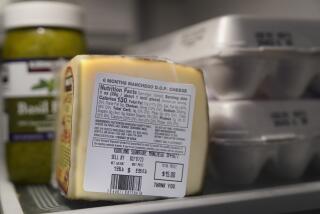Ever Wonder What Dates on Foods Signify?
- Share via
Pick any packaged food: If there’s a place to write on it, it probably has a date.
Many people believe that this date indicates some governmental protection, but it doesn’t necessarily have any official meaning. It doesn’t even have a uniform meaning: There are “sell by” dates, “use by” dates, packaging dates and dates of manufacture, and some are in code, meaningless to the consumer.
Not that government ignores supermarkets. “There are 123 government agencies that help supervise our business, with seven to eight inspections a day,” says Jan Charles Gray, senior vice president and general counsel for the Los Angeles-based Ralphs Grocery chain. They regulate food processing, labeling and grading, package weight and fill, store sanitation and pricing--on the item, on the shelf and at the counter.
They’re only occasionally interested in dated freshness, and not often for health reasons. Health concerns are, however, behind the unreadable code on cans, which identifies the canning date, plant, and batch number of the product--information necessary just for product recalls, such as the Bon Vivant case of 1971, when a New York man died of botulism poisoning from poorly processed vichyssoise. Codes must go on canned meat and poultry products (under the U.S. Department of Agriculture) and on low-acid canned vegetables and fruits (under the Food and Drug Administration), any of which, if improperly processed, could be harmful.
Only a manufacturer could understand “1AF 0563” (baked beans) or “2 5W297” (hominy), and the industry “prefers it that way,” says Tom Gardine in the FDA’s Center for Food Safety and Applied Nutrition. Canned goods, he says, “are geared for long-term distribution, and if people could identify the date, they’d probably buy only the most recent.”
Often a Requirement
Actually, the food could probably last, edible, as long as the can itself doesn’t break or rust away. “The product inside is essentially sterile,” says Robert Savage, food technologist in the food safety inspection service of USDA. “The quality may not be the same after a long time, but as far as safety, it’s all right.”
“Freshness dating,” indicating when a product should no longer be sold or eaten, is less critical: People don’t normally die from bread mold or sour milk. “The Health Department protects people from products which may be detrimental to their health, not from inferior quality,” says Jack Sheneman, food technology specialist in the food and drug branch of California’s Health Ser vices Department.
Nevertheless, dating perishable products is sometimes required by law--most commonly, milk products. “Milk is not the only perishable food, but it’s very perishable,” says Robert Boynton, executive director of California’s Dairy Institute in Sacramento, “and it’s difficult for the consumer to draw any conclusions prior to buying and opening it.” Dairy industry associations, moreover, tend to back such laws, being concerned with a generic image of what Boynton calls “consistency”: They want consumers to be able to “pick up any dairy product and know it’s going to be good.”
California, for example, requires that milk and milk products bear a “quality assurance date” after which the product should be taken off sale. Such “sell by” dates, set by the processor, are normally eight to 10 days after it leaves the plant for milk, perhaps 21 days for yogurt, and “up to six months for some cheeses in paraffin or a special coating,” says Richard Tate, chief of the milk and dairy foods control branch of California’s Food and Agriculture Department.
In California, the container has to be dated, but there’s no rule that the item has to be pulled on that date. By contrast, in New York City, fluid milk has to be not only dated but pulled off the shelves. (Until last summer, New York’s pull date for milk was four days after processing--a political ploy that kept out-of-state milk out of the competition. It’s now nine days.)
New York’s city council enacted rules for dating other perishable products as well, but markets don’t face fines for not pulling them on the dates, and health concerns (the purported basis for the milk-dating rules) don’t seem the prime consideration. Instead, the dating of baked goods, other dairy products, and prepackaged foods requiring refrigeration was meant simply to provide consumers with another tool to judge freshness and quality.
Just Guides
Even without guiding dates, the consumer can often see or taste deterioration for himself. (An exception is infant formula, which few people want to taste; by federal law it bears an expiration date.) He can also return the product and maybe never buy it again--a contingency most sellers would like to avoid. Many “sell by” and “use by” dates are therefore put on voluntarily by the manufacturer or distributor: “They would want the product pulled, to make sure the quality is good when it’s bought,” says Sheneman.
Ralphs Grocery Co., for one, requires that “almost every product we carry that has a perishable quality be labeled with a pull date,” Gray says “and the ones we manufacture or package have even shorter code dates.” Even then, the date is just a guide, for retailer as well as consumer. Meat, for example, “has a shorter shelf life than anything,” Gray says, “and any meat placed above the ‘load line’ in the refrigerated case deteriorates even faster. So it might be pulled even before the three-day pullout.”
More to Read
Eat your way across L.A.
Get our weekly Tasting Notes newsletter for reviews, news and more.
You may occasionally receive promotional content from the Los Angeles Times.










